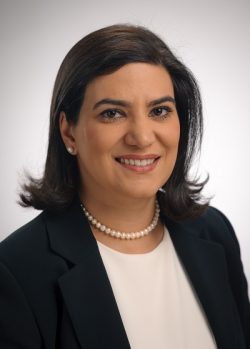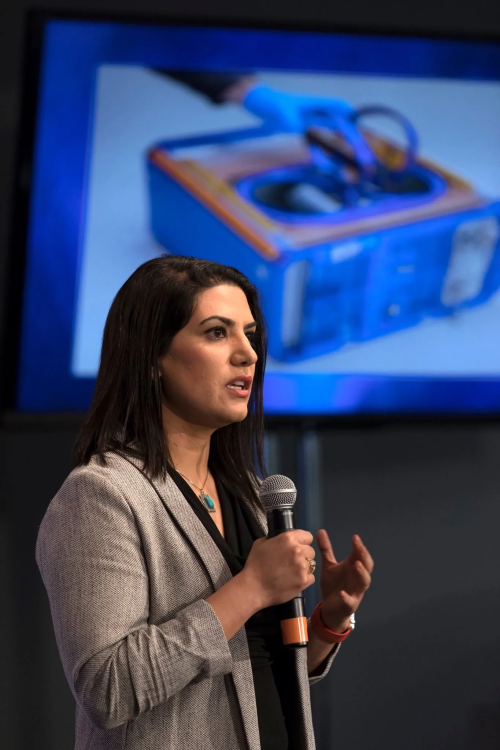
Yasaman Shirazi
Scientist, Space Biosciences Bioengineering Branch Chief, Space Biology Vertebrate Portfolio Lead
Phone: 650-604-4898
Email: yasaman.shirazi-fard@nasa.gov
Affiliation: NASA Ames Space Biosciences Bioengineering Branch
Professional Biography
- May 2021 – present: Co-Director NASA Ames Bone and Signaling Laboratory
- June 2020 – present: Space Biology Vertebrate Portfolio Lead, NASA Ames Research Center – Moffett Field, CA
- Feb 2020 – present: Co-Chair, Rodent Research Science Working Group
- Aug 2016 – June 2020: ISS Mission Scientist, NASA Ames Research Center – Moffett Field, CA
- Dec 2015 – Aug 2016: Hardware Engineer, NASA Ames Research Center – Moffett Field, CA
- May 2013 – Aug 2016: Postdoctoral Fellow, NASA Ames Research Center – Moffett Field,
- Aug 2012 – May 2013: Engineering Lecturer, Texas A&M University– College Station, TX
- Jul 2008 – May 2013: Research Assistant, Texas A&M University – College Station, TX
- Jan 2005 – May 2007: Research Assistant, Baylor University — Waco, TX
Education
Postdoctoral Fellowship in Molecular Biology, NASA Ames Research Center, 2013 – 2016
Ph.D. in Biomedical Engineering, Texas A&M University, May 2013
B.S. in Mechanical Engineering, Baylor University, May 2008. Outstanding Senior, Minor in Mathematics
Research Interests
My research focuses on better understanding the effects of the space environment (weightlessness and heavy ion radiation) on skeletal structure and strength, with the goal of reducing/preventing bone loss during spaceflight and promoting maximal recovery upon return to Earth. At NASA Ames Research Center and the NASA Space Radiation Laboratory (NSRL) at the Department of Energy’s Brookhaven National Laboratory (BNL) in New York we use ground-based analogue models to simulate the space environment. My research focuses on various exercise and mechanical unloading/loading models to study molecular mechanisms and assess bone microarchitecture (using micro-computed tomography) with the goal of developing countermeasures.
My team also aims to develop a novel, end-to-end technology for a point-of-care personalized biodosimeter by developing a microfluidic cartridge to carry out a benchtop assay with minimal training and crew time. This technology will prepare the sample to ultimately produce quantitative measurements of micro-RNAs for individuals exposed to radiation.
In addition to research, I currently lead the Biological and Physical Sciences (BPS) sponsored Rodent Research missions to help answer fundamental questions about human health, both for Earth and in space.
Media
Rodent Research Missions
Rodent Research–5 Mission
Rodent Research–6 Mission
Publications
- Sherina Malkani, Christopher R Chin, Egle Cekanaviciute, Marie Mortreux, Hazeem Okinula, Marcel Tarbier, Ann-Sofie Schreurs, Yasaman Shirazi-Fard, Candice GT Tahimic, Deyra N Rodriguez, Brittany S Sexton, Daniel Butler, Akanksha Verma, Daniela Bezdan, Ceyda Durmaz, Matthew MacKay, Ari Melnick, Cem Meydan, Sheng Li, Francine Garrett-Bakelman, Bastian Fromm, Ebrahim Afshinnekoo, Brad W Langhorst, Eileen T Dimalanta, Margareth Cheng-Campbell, Elizabeth Blaber, Jonathan C Schisler, Charles Vanderburg, Marc R Friedländer, J Tyson McDonald, Sylvain V Costes, Seward Rutkove, Peter Grabham, Christopher E Mason, Afshin Beheshti. “Circulating miRNA Spaceflight Signature Reveals Targets for Countermeasure Development.” Cell reports 33 (10), 108448.
- Andrea Ballerini, Corrine Ying Xuan Chua, Jessica Rhudy, Antonia Susnjar, Nicola Di Trani, Priya R Jain, Grit Laue, Danuta Lubicka, Yasaman Shirazi‐Fard, Mauro Ferrari, Louis S Stodieck, Samuel M Cadena, Alessandro Grattoni. “Muscle Atrophy: Counteracting Muscle Atrophy on Earth and in Space via Nanofluidics Delivery of Formoterol (Adv. Therap. 7/2020)”. Advanced Therapeutics 3 (7), 2070014.
- Sungshin Y Choi, Amanda Saravia-Butler, Yasaman Shirazi-Fard, Dennis Leveson-Gower, Louis S Stodieck, Samuel M Cadena, Janet Beegle, Stephanie Solis, April Ronca, Ruth K Globus. “Validation of a new rodent experimental system to investigate consequences of long duration space habitation”. Scientific reports 10 (1), 1-17.
- Megan E Rosa-Caldwell, Jacob L Brown, Richard A Perry Jr, Kevin L Shimkus, Yasaman Shirazi-Fard, Lemuel A Brown, Harry A Hogan, James D Fluckey, Tyrone A Washington, Michael P Wiggs, Nicholas P Greene. “Regulation of mitochondrial quality following repeated bouts of hindlimb unloading”. Applied Physiology, Nutrition, and Metabolism 45 (3), 264-274.
- Beheshti A, Shirazi-Fard Y, Choi S, Berrios D, Gebre SG, Galazka JM, Costes SV. “Exploring the Effects of Spaceflight on Mouse Physiology using the Open Access NASA GeneLab Platform.” JoVE 2018 e58447.
- Shimkus KL, Shirazi-Fard Y, Wiggs MP, Ullah ST, Pohlenz C, Gatlin III DM, Carroll CC, Hogan HA, and Fluckey JD. “Responses of skeletal muscle size and anabolism are reproducible with multiple periods of unloading/reloading.” J App. Phys 125 (5) 1456-1467.
- Childress P, Brinker A, Gong CS, Harris J, Olivos DJ, Rytlewski JD, Scofield DC, Choi SY, Shirazi-Fard Y, McKinley TO, Chu TG, Conley CL, Chakraborty C, Hammamieh R, Kacena MA. “Forces Associated with Launch into Space do not Impact Bone Fracture Healing.” Life Sciences in Space Research 16 (2018) 52-62.
- Alwood AS, Tran LH, Schreurs AS, Shirazi-Fard Y, Kumar A, Hilton D, Tahimic CGT, Gobus RK. “Dose- and Ion-Dependent Effects in the Oxidative Stress Response to Space-like Radiation Exposure in the Skeletal System.” Int J of Molecular Sciences 18:10 (2017).
- Ghosh Y, Behnke BJ, Stabley JN, Kilar CR, Park Y, Narayanan A, Alwood JS, Shirazi-Fard Y, Schreurs A-S, Globus RK, Delp MD. “Effects of High-LET Radiation Exposure and Hindlimb Unloading on Skeletal Muscle Resistance Artery Vasomotor Properties and Cancellous Bone Microarchitecture in Mice.” Rad Res, 186 (3), 254-263.
- Schreurs AS, Shirazi-Fard Y, Shahnazari M, Alwood JS, Truong TA, Tahimic CGT, Limoli CL, Turner ND, Halloran B, Globus RK. “Dried Plum Protects from Bone Loss Caused by Ionizing Radiation.” Scientific Reports, 6 (21343) 1-11.
- Macias BR, Lima F, Swift JM, Shirazi-Fard Y, Greene ES, Allen MR, Fluckey JD, Hogan HA, Braby L, and Bloomfield SA. “Simulating the Lunar Environment: Partial Weightbearing and High-LET Radiation Induces Bone Loss and Sclerostin-Positive Osteocytes.” Rad. Res. 2016 Sep;186(3):254-63
- Shirazi-Fard Y, Alwood JS, Schreurs AS, Castillo AB, Globus RK. “Mechanical loading causes site-specific anabolic effects on bone following exposure to ionizing radiation.” Bone 81 (2015) 260-269.
- Shirazi-Fard Y, Metzger CE, Kwaczala AT, Judex S, Bloomfield SA, and Hogan HA. “Moderate Intensity Resistive Exercise Improves Metaphyseal Cancellous Bone Recovery following Disuse Period, but does not Mitigate Decrements during Subsequent Disuse Period in Adult Rats.” Bone 66 (2014) 296-305.
- Shirazi-Fard Y, Anthony RA, Kwaczala AT, Judex S, Bloomfield SA, and Hogan HA. “Previous exposure to simulated microgravity does not exacerbate bone loss during subsequent exposure in the proximal tibia of adult rats.” Bone 56 (2), 461-473.
- Shirazi-Fard Y, Kupke JS, Bloomfield SA, and Hogan HA. “Discordant recovery of bone mass and mechanical properties during prolonged recovery from disuse.” Bone 52 (1), 433-443.
- Boudreaux RD, Metzger CE, Macias BR, Shirazi-Fard Y, Hogan HA, Bloomfield SA. “Bone loss during partial weight bearing (1/6th gravity) is mitigated by resistance and aerobic exercise in mice.” Acta Astronautica 99 (2014) 71-77.
- Swift JM, Lima F, Macias BR, Allen MR, Greene ES, Shirazi-Fard Y, Kupke JS, Hogan HA, and Bloomfield SA. “Partial weightbearing does not prevent musculoskeletal losses associated with disuse.” Medicine & Science in Sports & Exercise Vol. 45, No. 11, pp. 2052–2060, 2013.



























